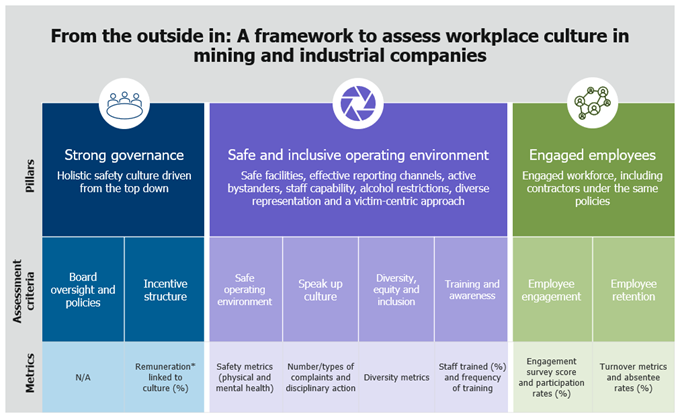Culture can catalyse or undermine business success. It cannot be bought; it can only be created. Yet, this critical element is complicated to measure and assess from the outside. This presents a challenge for us as investors.
Overview
Following the extent of sexual harassment, bullying and racism highlighted in Rio Tinto’s recent workplace culture report, we undertook a research and engagement project to explore the related risks across the industry and deepen our understanding of the factors that can drive, or mitigate, harmful behaviour within a company. Industry reports and one-on-one interviews with ten ASX200 companies in the mining and industrial sectors formed the basis of the investigation.
Despite its multifaceted and obscure nature, we believe a perspective on company culture can be obtained from the outside. We have subsequently developed a framework for investors to assess workplace culture that is characterised by three overarching pillars:
- Strong governance: A holistic safety culture driven from the top-down, with Board oversight and remuneration tied to People and Culture.
- Safe and inclusive operating environment: A speak up culture and strong diversity, equity and inclusion strategy integrated through the operating environment, together with effective training and awareness programs. Disclosures around complaints, incidents and disciplinary action remain uncommon in company reporting today, but demonstrate the cultural health of a business and leadership in transparency.
- Engaged employees: An engaged workforce that includes contractors under the same policies, supported by a strong engagement survey approach and transparent reporting of turnover and absenteeism data.
This framework has been developed based on company engagement and industry research.

*Short-term and long-term incentives related to Executive compensation.
Project outcomes
- Workplace culture assessment framework: Eight criteria and specific underlying metrics form a unique assessment framework that can be used to evaluate a company’s workplace culture.
- Workplace culture evaluation: A preliminary assessment against the framework has been completed for a suite of mining and industrial companies. This analysis is provided in an anonymous format in this report, alongside good practice examples, the key metrics that we ask companies to disclose and suggested questions for other stakeholders to complete similar assessments.
- Disclosure requirements: We encourage companies to engage with investors on this important issue and improve transparency on the metrics identified in this report.
- ESG integration: The outcomes of the workplace culture analysis will be embedded within our ESG assessment processes and used to inform future engagements and track progress, especially for identified higher risk companies.
- Offering company feedback: We intend to provide detailed feedback to the companies we engaged with, particularly where gaps in disclosure against the framework criteria have been identified.
Conclusion
The companies involved in the project were receptive to taking part in the interviews and generous with their insights. We thank them for their openness and interest in the project. We hope that by publishing our insights and the framework companies will improve their reporting practices and other stakeholders can make similar assessments and take part in more informed discussions on workplace culture.
The implications going forward are for companies to manage human capital and their own culture so that employees are safe, reputational and regulatory risks are managed and talent is attracted and retained. Investors too have a responsibility to encourage stronger disclosures, keep companies accountable for staff wellbeing and safety and manage this ESG issue within portfolios. We hope that investors consider applying this framework and continue to advocate for a transformed mining industry that is safe for all and more inclusive in future.
To view the full report and findings in more detail, please click here.
In the Appendix on page 14-18 of this report, we provide:
- Information we seek in company reporting
- Good practice examples
- Suggested questions to guide workplace culture assessments




